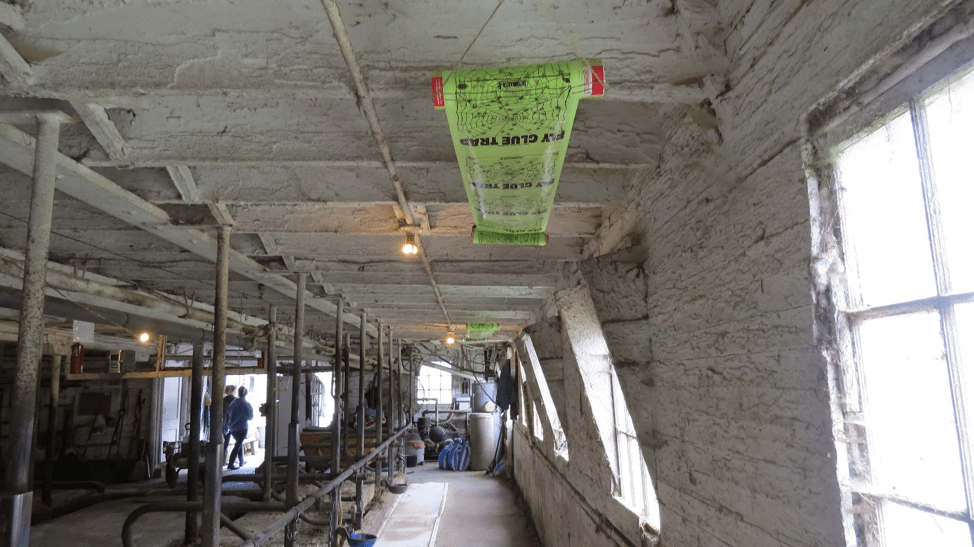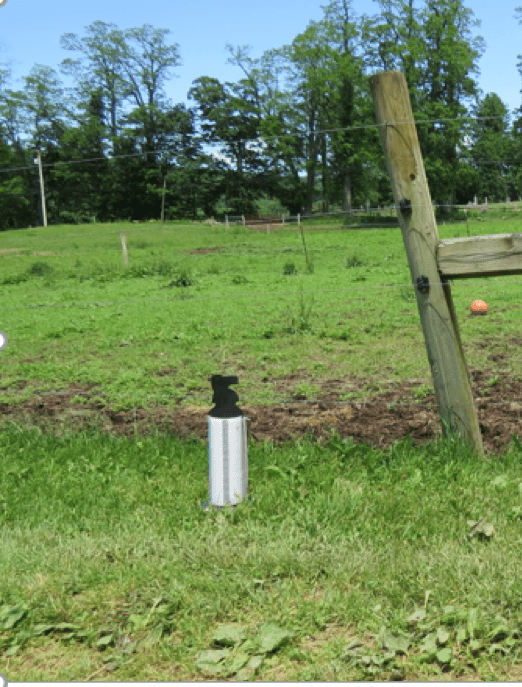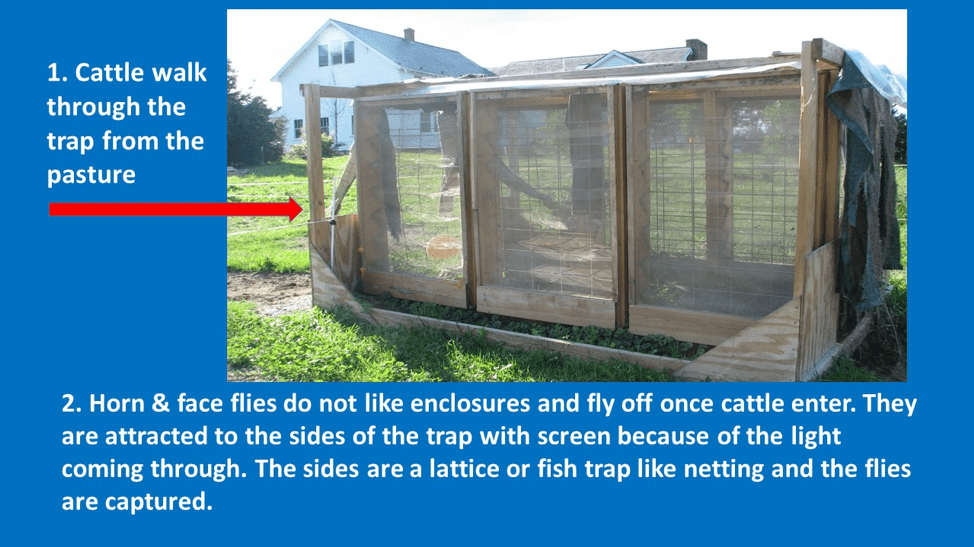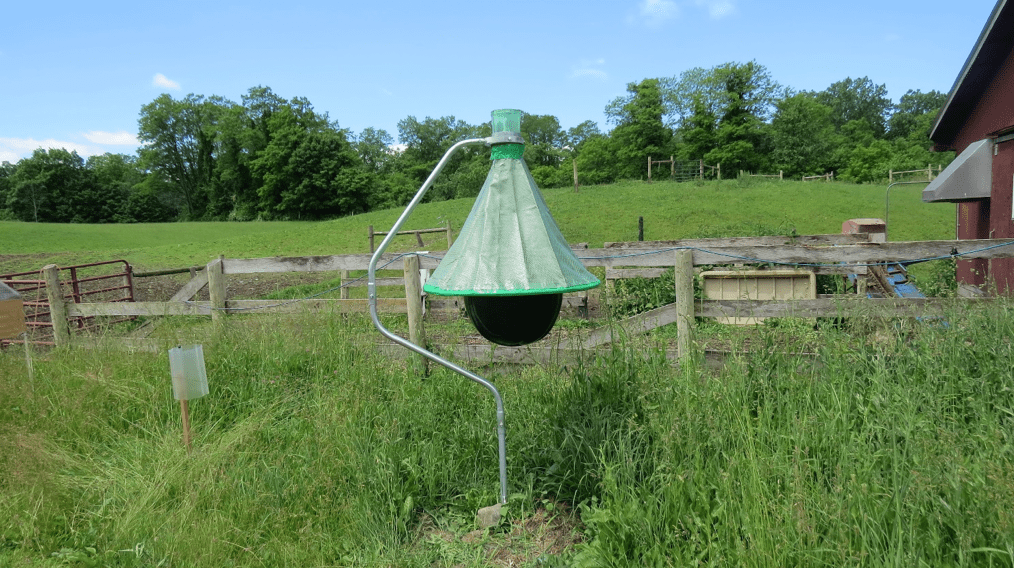
Post by Ken Wise, Livestock & Field Crops IPM Extension Area Educator
We have set up two dairy fly IPM summer-long demonstrations. The demonstrations are in Essex and Dutchess Counties. Along with Jennifer Fimbel (Dutchess County Cornell Extension Educator) and Carly Summers (Essex County Cornell Extension Educator), we have set up two summer long demonstration with Shunpike Dairy and North Country Creamery Dairy.
There are several species of flies that cause cattle problems and we break them into two categories: barn flies and pasture flies. In the barn we have stable flies (biting) and house flies (non-biting), and on pasture we have stable flies (biting), horn flies (biting), face flies (non-biting), horse flies (biting) and deer flies (biting).

Barn Flies: Both house and stable flies reproduce and develop in moist, rotting organic matter. This includes moist hay, straw, manure, feed or any rotting material in contact with the ground (soil or concrete). Stable flies need to take blood meals to reproduce. These flies like to bite the legs of the animals. Houseflies do not bite but can occur at high numbers. They annoy the animals and can transmit various diseases.
Keeping areas around the barn clear of this organic matter reduces barn fly issues dramatically. BUT…Even while keeping barns clean, these flies can still become problematic as the summer progresses.
The use of biological control can help keep populations lower if you start in the early summer. Releasing specific parasitoids around the barns works like smart bombs by laying eggs inside of the pupa of stable and house flies. They hatch and will eat the pupa before it can an adult fly. There are many types of fly traps that can be employed to control barn flies. You can purchase parasitoids for weekly releases from IPM Labs .
We have set up several fly traps for demonstration to aid in controlling these flies in or around the barns to monitor fly populations and efficacy of the various traps for the summer.
PRO SERIES SPIDERWEB™ FLY GLUE TRAP (AKA Giant Glue Trap) (house flies and some possible stable flies)

Knight Stick (stable flies are attracted to a blue spectrum of light that is reflected)

Olsen Biting Fly Trap (stable flies are attracted to a blue spectrum of light that is reflected)

Insecticides can be used in the barn if threshold levels have been met or exceeded. Place 3 by 5-inch spot cards in different areas of the barn where flies congregate. When houseflies rest they regurgitate their food and leave a spot on the wall, or in this case the card. If a card receives 100 spots per card per week, it has reached the action threshold. Make every attempt to find where the flies are breeding and reproducing and eliminate the moist organic matter. If there is still a problem, and only as a last resort, an insecticide can be used. (Make sure you read and follow the insecticide label before use)
Pasture Flies: While stable flies breed in moist organic matter horn and face flies reproduce in fresh cow pats. Within a minute or so, after a cow defecates, the flies lay eggs in the pat. Horn flies live 90 percent of the time on cattle and need blood to reproduce. Each fly can take 20 blood meals a day. That is a lot of biting on the animals. Face flies feed on secretions from the animal around the eyes and nose. They will also feed on a wound or cut. Face flies also transmit pink eye and infect animals with a nematode eye worm (Thelasia sp.). Horn flies can be controlled with a walk through trap (Bruce Trap) or a Cow Vac. A second method is to drag a light harrow to spread out the manure pat and make it thin and dry out. This will kill the fly maggots in the manure pat.
Walk through trap (Bruce Trap)


The flies can also be controlled with insecticides if certain thresholds have been met. The threshold for face fly is an average of 10 flies per face across the herd and horn fly is an average of 50 per side of the animal. Note that horn flies are ½ the size of the house fly, and feed on the back, side or belly of the cattle. The threshold for stable flies in the barn or on pasture is an average of 10 flies per 4 legs. You will need to monitor about 15 animals in the herd to determine thresholds.

There are also horse and deer flies (both biting flies) that can feed on cattle. While they occur to a lesser degree that other cattle flies they do take blood meals and are very painful. They reproduce in wet areas in and around forests. They will land on the cattle, take blood and leave in seconds. This is why insecticides do not work on these two biting flies, because there is not enough exposure to the insecticide. We set up two traps that catch stable, horse and deer flies on each farm.


We will host field meetings in association with the demonstrations during which we will demonstrate and discuss IPM for flies on cattle and general pasture management. Meeting dates will be posted soon.


524 Bradfield Hall, Cornell University, Ithaca NY, 14853